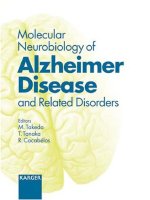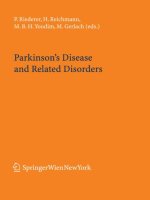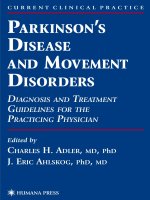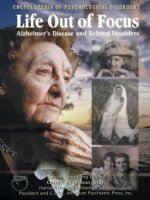PARKINSON’S DISEASE AND RELATED DISORDERS - PART 7 pot
Bạn đang xem bản rút gọn của tài liệu. Xem và tải ngay bản đầy đủ của tài liệu tại đây (1.26 MB, 10 trang )
©2004 CRC Press LLC
Figure 44 Macroscopic view of the brain in corticobasal degeneration. The
leptomeninges have been partially removed to show cortical atrophy involving
the posterior frontal and anterior parietal regions
©2004 CRC Press LLC
Figure 46 Histological sections of cerebral cortex showing swollen cortical
neurons in corticobasal degeneration with an appearance resembling chromato-
lysis (H & Es)
Figure 45 Histological sec-
tion of cerebral cortex in
corticobasal degeneration
shows severe gliosis and an
achromatic neuron (H & E)
©2004 CRC Press LLC
Figure 48 Dorsal (left) and palmar (right) views of dystonic posturing of the left
hand of a patient with corticobasal degeneration. In particular, note the ulnar deviation
at the wrist and the abducted posture of the little finger
Figure 47 Histology of
cerebral cortex in cortico-
basal degeneration shows a
putaminal neuron (arrowed)
containing a basophilic inclu-
sion (H & E)
©2004 CRC Press LLC
A B
C
Figure 49 This patient with corticobasal degener-
ation shows ideomotor apraxia of the left hand.
When asked to copy three hand postures (A–C,
lower), in each instance, the patient's version was
defective (A–C, upper)
©2004 CRC Press LLC
Figure 50 In this patient
with corticobasal degenera-
tion, sagittal T
1
-weighted
MRI (upper) shows predomi-
nantly posterior frontal and
parietal atrophy (arrowed).
Coronal T
2
-weighted MRI
(lower) shows that the pari-
etal atrophy is asymmetrical
©2004 CRC Press LLC
Figure 51 [
18
F]-fluorodeoxyglucose–
PET scan shows reduced metabolism in
the left frontoparietal cortex and left
striatum in a patient with corticobasal
degeneration
Figure 52 Scoliotic posture in a patient
with idiopathic torsion dystonia
©2004 CRC Press LLC
Figure 53 Abnormal neck posture in a
patient with idiopathic torsion dystonia
Figure 54 Blepharospasm: Still photograph taken from a videorecording.
The condition proved responsive to botulinum toxin
©2004 CRC Press LLC
Figure 55 Abnormal neck
posture in a patient with
spasmodic torticollis
Figure 56 Mechanisms of actions of
various botulinum toxins (BTX). Ach,
acetylcholine
©2004 CRC Press LLC
Figure 57 Dystonic postur-
ing of the hand consequent
to perinatal hypoxia
Figure 58 Dystonic postur-
ing of the foot consequent
to perinatal hypoxia. There is
inversion of the foot and
relative dorsiflexion of the
big toe of the patient’s left
foot compared with the right
©2004 CRC Press LLC
Figure 59 CTs showing focal ischemic
change (black arrows) in the right frontal
region with deep extension and dilatation of
the right frontal horn (white arrow)









